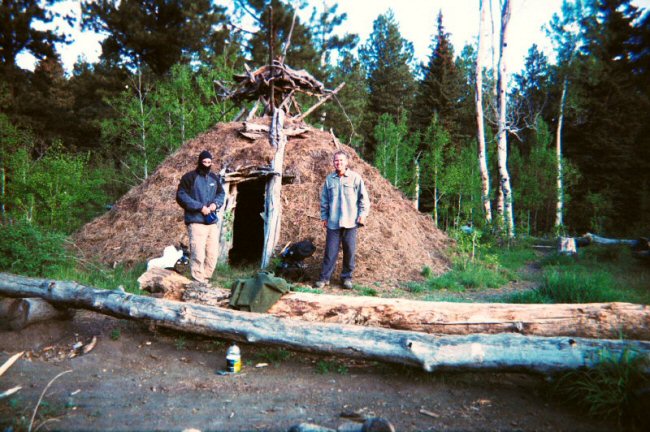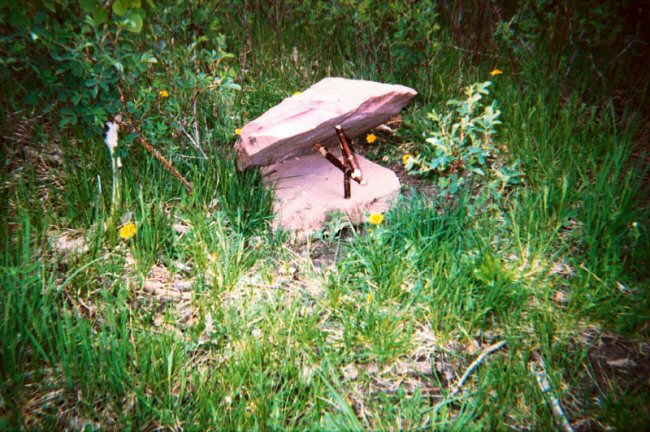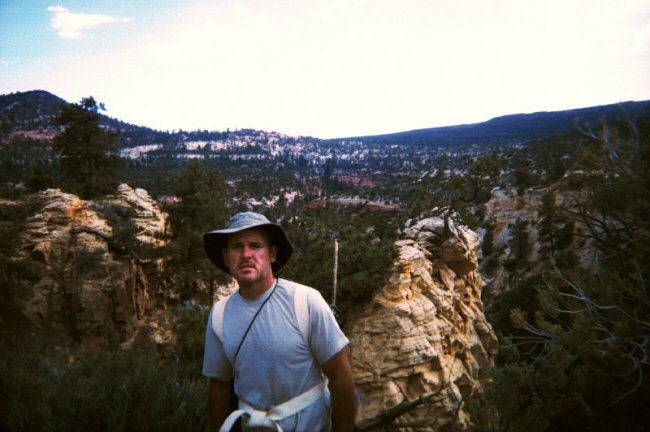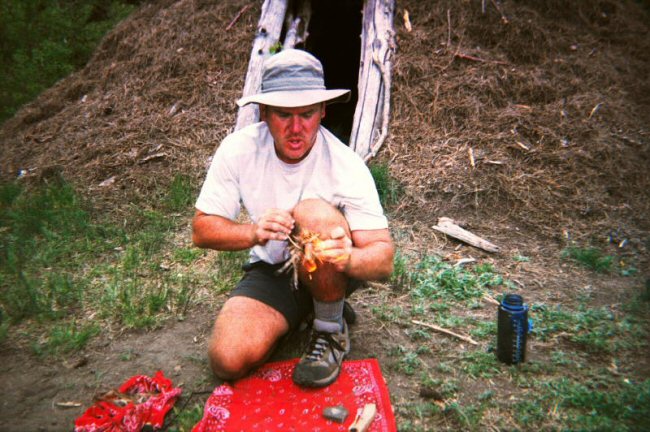BOSS 7-Day Field Course
Ron Medise
BOSS (Boulder Outdoor Survival School) is the oldest and best-known survival school around. In business since 1968, they have a strong tradition in low-tech wilderness education and survival skills. My adventure began on a Saturday morning, when the BOSS van picked me and 11 other “outdoor fanatics” up at our motel and we started our 4-hour drive to Boulder, Utah. After arriving to BOSS’s base camp and receiving an orientation, equipment review, and a fitness evaluation, we headed into the field. (A note to anyone who may be interested in completing this course: ** BOSS’s field courses are very physically and emotionally challenging.) Prior to my trip, I read a lot about BOSS, and knew of the grueling long treks, so for 6 months I trained by jogging daily and going on long day hikes. This conditioning proved to be essential and was a key to my success in the field.
During the following 7 days, we hiked over 100 grueling miles down steep red rock canyons and over boulder-covered mountaintops with little or no food and water. Temperatures soared to the 90’s in the heat of the day and then dropped quickly into the 40’s as the sun fell.
The first phase of the course was called Impact, during which time we were limited to the clothes on our back and nothing else. We hiked far into the darkness of Dixie National Forest, where most of my classmates just passed out on the cold desert floor when we finally came to rest for the evening. The first night was the coldest by far. I awoke after a very brief nap and stumbled in the darkness for handfuls of debris to construct a primitive debris bed to elevate my shivering body off the cold desert ground. This proved to be a smart move on my part, as I spent the rest of the night much warmer than my fellow hikers.
The sun rose quickly the next morning and we were off again, hiking over 25 miles through some of the most beautiful yet rugged terrain I have ever seen. As the hours passed without water or food, many of the students had to be carried along the narrow trails. Exhausted and filthy, we arrived into a base camp on the second night and one of our instructors quickly made a small fire with a matchless friction fire set. Impact was finally over, and we received our minimum equipment packs and some food rations. During the remainder of the course we were able to carry a poncho, a knife, an enamel cup, some cordage, some addition clothing, two water bottles and a wool blanket. We wrapped our minimum gear into the blanket and used the cord to make a blanket pack that was worn like a backpack. We camped in large debris-covered Wickiups and spent the next day learning and practicing the skills needed to survive this vast sagebrush-covered landscape. We learned to navigate by the sun, build various shelters, weave cordage from plant fibers, procure water from this arid terrain, and create fire from friction. We also constructed several types of traps and I was successful with one of my figure-four deadfall traps at nabbing a ground squirrel for my dinner.
We spent the next several days exploring and hiking through some of Utah’s most stunning landscapes. Each night we constructed our own shelters and friction fires, and we cooked our meals over an open flame. I dined on a variety of local plant life, ash cakes and lentil soup. Before eating, we had to carve wooden spoons and spatulas to eat with. I quickly realized the principle behind “The more you know the less you need”. On day six, the group was broken up for our individual solo; this was a time to put the skills we learned to the test, alone in the silence of these spectacular canyon walls and juniper-covered land. Here I spent my time alone at my campsite putting the final touches on my newly created fireboard, spoon, and traps. I also constructed a shade shelter to make myself more comfortable in the desert heat. During solo I had lots of time to reflect back on my journey, as I watched birds hopping through the swaying cottonwood trees, and lizards scuttling along the small rocks and fragrant sage-covered flatlands. It was during this solo time, while staring at my filthy body and drinking my silty warm water, that I came to two earth-shattering revelations. 1. I missed my family back in Florida. 2. I was REALLY hungry. My fantasies began to whirl around pizza and steak, and spicy chicken wings from my favorite bar back home. With all the thoughts of food filling my mind, the sun began to disappear below the canyon walls signaling it was time to meet up with the rest of the group. After the solo, we had our last meal together just outside the entrance to a shallow cave. We talked about our adventure and shared are solo experiences with all. We had traveled great distances (10-20 miles daily) and were pushed well beyond out physical limits during this week, and we were glad to be going home. However, we were in for one last surprise. Our instructors informed us that we were entering the Final Challenge. I would love to tell you about what that entailed, but that would be giving away top-secret information. You’ll just have to trust me when I say it was quite the experience. Let me reiterate an earlier point: The BOSS field course is not for every one. Many of my fellow classmates passed out along the way, suffered nosebleeds, and threw up due to heat exhaustion and lack of water.
Besides learning useful primitive and survival skills, I learned more about myself and my inner strength. I will never forget the 7 days I spent in the southern deserts of Utah. I will always remember the feeling of triumph and personal satisfaction of starting my own fires, catching my own meals, and hiking farther and longer than I ever thought myself capable of. Perhaps I’m not ready to live out the rest of my days inside a hollow tree as Sam Gribley did in my favorite childhood book. But for one week of my life, I WAS that young man, casting aside modern conveniences and surviving only on pure determination, willpower, and my own cunningness. It is a memory and an experience that will stay with me forever.
You know, I also loved “The Adventures of Huckleberry Finn” as a kid. Does anyone know how to make a wooden raft?
A Wickiup.

Figure 4 deadfall.

Utah landscape.

Lighting a tinder bundle.

©2004 Ron Medise